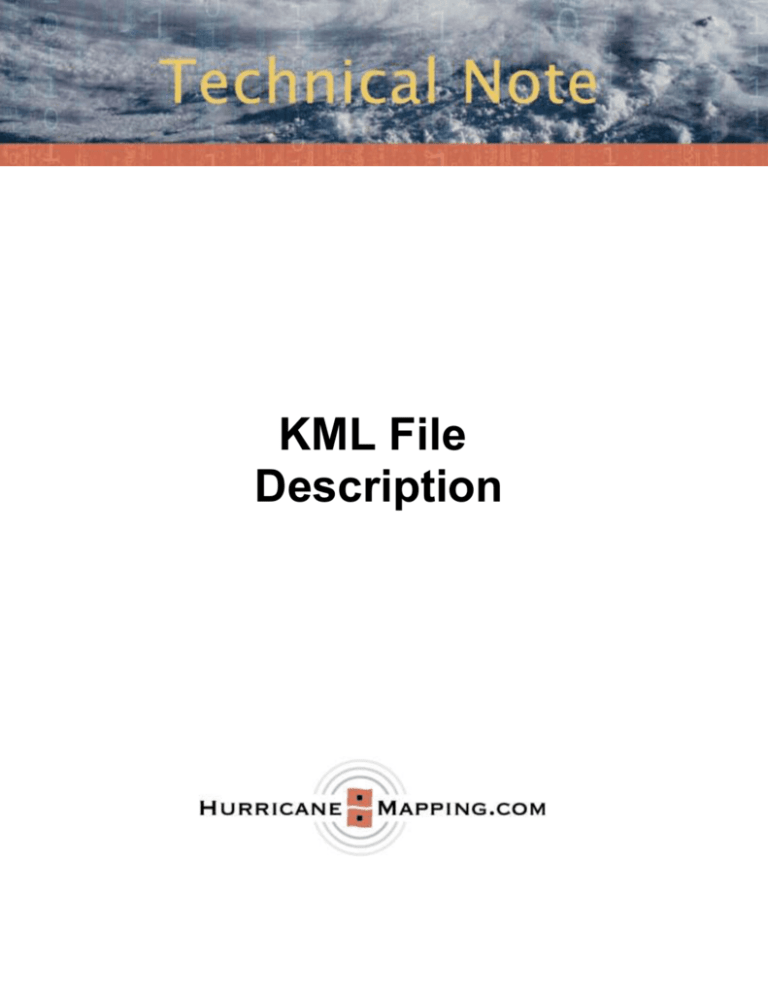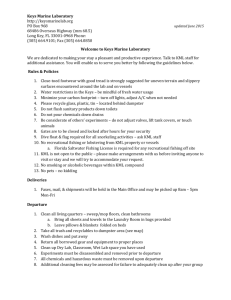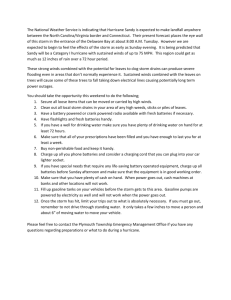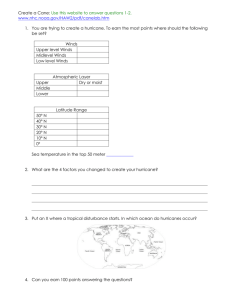
KML File
Description
TABLE OF CONTENTS
Introduction
2
File Formats
What are KML and KMZ Files?
HurricaneMapping KML Files
2
2
2
Data Distribution
Advisory Issuance Times
Live Storms
Archived Storms and Advisories
3
3
3
3
Map Layers
Current Location
Future Track
Past Track
Watches/Warnings
4
6
7
11
14
Technical Support
15
Legal Notices
15
www.hurricanemapping.com
KML File Description, Ver 1.0
Page 1
Introduction
This manual describes the file format and types of map layers contained within
HurricaneMapping.com’s KML storm advisory files. These files are designed for
storm tracking and visualization purposes within Google Earth software. The
map layers are derived from National Hurricane Center, Central Pacific Hurricane
Center, and Joint Typhoon Warning Center forecast advisories issued for tropical
depressions, tropical storms, and hurricanes or typhoons.
HurricaneMapping servers ingest these official government forecasts, then model
and convert the data to map layers. KML storm advisory files can be
downloaded from http://www.hurricanemapping.com/data using a web browser.
Advisories from live storms may also be automatically retrieved from
HurricaneMapping’s servers through a network link within Google Earth. These
features require a HurricaneMapping .com subscription with userid and password
login.
File Formats
What are KML and KMZ Files?
Keyhole Markup Language, or KML, is an XML-based language for geospatial
data. KML describes not only the geospatial elements, but also styling rules for
the elements’ graphic display. Keyhole, Inc. first developed the language and
software application that is now known as Google Earth. Due to the popularity of
the KML format and Google Earth, a number of other mapping programs are
beginning to adopt the format as well.
KML data is often distributed in the form of a KMZ, consisting of a zipped doc.kml
file and associated other files. A KMZ is smaller in size and more portable than
straight KML, making it the ideal format for distributed data. No unzipping step is
necessary--Google Earth will load KMZ files directly into the program just as it
does with KML.
HurricaneMapping KML Files
HurricaneMapping’s storm advisories are packaged as KMZ files. They contain a
doc.kml file plus a folder of custom icons. HurricaneMapping files use KML 2.1
and thus require Google Earth version 4.0.2 or higher for correct display. You
may find some use for HurricaneMapping files in other programs that read KML,
however the format for these storm advisories has been optimized for use in
Google Earth.
www.hurricanemapping.com
KML File Description, Ver 1.0
Page 2
Data Distribution
Advisory Issuance Times
The Hurricane Centers have the following standard times for forecast advisory
issuance:
09 UTC
15 UTC
21 UTC
03 UTC
(5 AM EDT) Where UTC is also known as GMT or Zulu
(11 AM EDT)
(5 PM EDT)
(11 PM EDT)
In actual practice, issuance of the Hurricane Center advisory often is up to 30
minutes earlier. A HurricaneMapping KML file is ready for retrieval less than 5
minutes later. Intermediate advisories having a letter extension of A or B are
issued at 2 or 3-hour intervals when storms are nearing landfall.
HurricaneMapping’s servers also prepare these intermediate advisories as well.
HurricaneMapping’s KML datafeed is subscription-based. Subscribers (with
user-id and password) have several options for retrieving KML storm data from
HurricaneMapping’s web server.
Live Storms
HurricaneMapping furnishes subscribers with an ‘Active Tropical Storms’ network
link for live storm tracking. As long as Google Earth is running and your "Active
Tropical Storms" network link is checked on, you will receive hourly updates of
new storms and advisories.
Archived Storms and Advisories
Individual advisories from both current and historical storms may be downloaded
using a web browser, via login to http://www.hurricanemapping.com/data. A
KMZ file is named according to the storm name, advisory number, and year in
which it occurred (i.e. Katrina22A_2005.kmz for an intermediate advisory and
Isabel10_2003.kmz for a main advisory)
www.hurricanemapping.com
KML File Description, Ver 1.0
Page 3
Map Layers
HurricaneMapping’s KML files will contain various map layers depending on the
conditions of the storm. Here we have loaded into Google Earth, the file
Katrina22_2005.kmz.
Four folders appear on the left under the heading “Hurricane KATRINA, NHC
Advisory #22, from HurricaneMapping.com”
Current Location
Future Track
Past Track
Watches/Warnings (this folder will not be present for storm advisories with
no watches or warnings issued)
Expanding these folders, we see the following list of map layers appear:
www.hurricanemapping.com
KML File Description, Ver 1.0
Page 4
www.hurricanemapping.com
KML File Description, Ver 1.0
Page 5
Current Location
The Current Location folder consists two items: location of the storm center at the
time of advisory issuance and the extent of winds surrounding the storm center.
The rings represent the extent of tropical storm force winds (34kt or 39mph) in
blue, 50kt or 58mph winds in yellow, and hurricane force (64kt or 74mph) winds
in red.
Click on the hurricane icon on the map or on the legend, and an information
balloon will appear on the map as shown below.
www.hurricanemapping.com
KML File Description, Ver 1.0
Page 6
Future Track
The Future Track folder consists of 4 items: path, forecast positions, wind swath,
and error swath.
Path is a solid white line ahead of the storm, representing where the storm center
is projected to track within the next 3 to 5 days (72 to 120 hours).
Forecast Positions are the blue and white squares along the forecasted path.
The Hurricane Center issues storm location and intensity projections for up to
seven time periods--12, 24, 36, 48, 72, 96, and 120 hours into the future. They
are labeled with the date and time.
www.hurricanemapping.com
KML File Description, Ver 1.0
Page 7
Shown below, we have expanded forecast positions item in the legend and
double-clicked on the 36-hour forecast position. Google Earth flies into a closer
view of that location and displays an information bubble containing storm
statistics projected at that time.
www.hurricanemapping.com
KML File Description, Ver 1.0
Page 8
Wind Swath represents a composite of wind ranges throughout a 72-hour
forecast period.
The fill colors represent the extent of tropical storm force winds (34kt or 39mph)
in blue, 50kt or 58mph winds in yellow, and hurricane force (64kt or 74mph)
winds in red.
www.hurricanemapping.com
KML File Description, Ver 1.0
Page 9
Error Swath is the large white swath in the middle represents the area in which
the storm center is most likely track within the next 72 hours(3 days). The swath
gets wider at a rate equal to the average error rate per hour of forecast, and thus
is quite wide in the latter hours. This reflects the uncertainty in the hurricane
forecast process. The swath means that even though the Hurricane Center has
forecast a specific track, the storm could end up anywhere within the swath
within the next 72 hours, with around a 60% confidence level.
Tropical storm force winds (72-hr error plus winds >39mph) might occur in the
larger, lighter gray region if the storm tracked at the outer edge of the error
swath.
The transparent area bordered by a gray ellipse represents the Average Error
Swath for 73 to 120 hours (5 days). (This is cut off in the illustration below)
www.hurricanemapping.com
KML File Description, Ver 1.0
Page 10
Past Track
The Past Track folder consists of three items: path, advisory positions, and wind
swath.
Path is the solid blue line behind the storm, representing the actual path the
storm has taken.
Advisory positions, squares along the past track path, are the observed locations
of the storm center at the time of previous advisory issuances. They are colored
according to the maximum intensity of winds at those times—blue if a tropical
storm (>34kt or 39mph winds), yellow if winds over 50kt or 58mph, and red if a
hurricane (>64kt or 74mph winds).
www.hurricanemapping.com
KML File Description, Ver 1.0
Page 11
Shown below, we have double-clicked on an old advisory position—Intermediate
Advisory 10A over the tip of Florida. Google Earth flies into a closer view of that
location and displays an information bubble containing storm statistics from that
time.
www.hurricanemapping.com
KML File Description, Ver 1.0
Page 12
Wind swath represents a composite of observed wind ranges from past
advisories.
The fill colors represent the extent of tropical storm force winds (34kt or 39mph)
in blue, 50kt or 58mph winds in yellow, and hurricane force (64kt or 74mph)
winds in red.
www.hurricanemapping.com
KML File Description, Ver 1.0
Page 13
Watches/Warnings
Watches and warnings appear as lines along the coast and as flags marking the
starting and ending location for each item.
Hurricane warnings (red) are issued when hurricane conditions are expected
within 24 hours and hurricane watches (pink) are issued when hurricane
conditions are possible within 36 hours. Tropical storm warnings (blue) are
issued where those conditions are expected within 24 hours and tropical storm
watches (green) are issued when that threat is possible within 36 hours.
www.hurricanemapping.com
KML File Description, Ver 1.0
Page 14
Technical Support
Help for this and all other HurricaneMapping products and services is available
24/7 at support@hurricanemapping.com or (843) 881-0593, alternate (804) 3574292.
Legal Notices
©2007 Sea Island Software, Incorporated. All rights reserved.
HurricaneMapping KML File Description, Ver. 1.0
This document is furnished under subscription and may be used or copied only in
accordance with the terms of the HurricaneMapping subscription agreement.
The contents of this document are subject to change without notice and do not
represent a commitment on the part of the Sea Island Software, Inc.
Google Earth ™ is a trademark of Google
Products named herein may be trademarks of their respective manufacturers and
are hereby recognized. Trademarked names are used editorially, to the benefit
of the trademark owner, with no intent to infringe on the trademark.
www.hurricanemapping.com
KML File Description, Ver 1.0
Page 15








